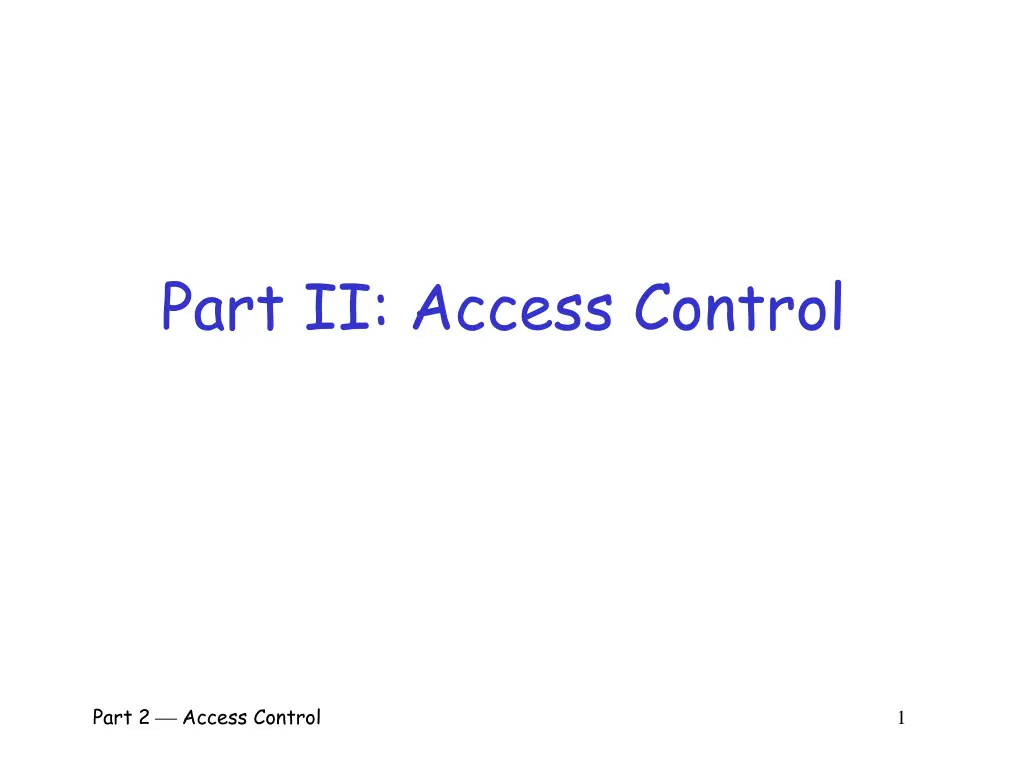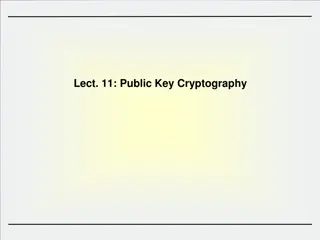
Effective Strategies for Access Control in Cybersecurity
Discover the vital aspects of access control in cybersecurity, including authentication and authorization. Explore the challenges with passwords, the importance of secure authentication methods, and the comparison between keys and passwords. Learn why passwords are still prevalent despite their drawbacks and the difference between good and bad password practices.
Download Presentation

Please find below an Image/Link to download the presentation.
The content on the website is provided AS IS for your information and personal use only. It may not be sold, licensed, or shared on other websites without obtaining consent from the author. If you encounter any issues during the download, it is possible that the publisher has removed the file from their server.
You are allowed to download the files provided on this website for personal or commercial use, subject to the condition that they are used lawfully. All files are the property of their respective owners.
The content on the website is provided AS IS for your information and personal use only. It may not be sold, licensed, or shared on other websites without obtaining consent from the author.
E N D
Presentation Transcript
Part II: Access Control Part 2 Access Control 1
Access Control Two parts to access control Authentication: Are you who you say you are? o Determine whether access is allowed o Authenticate human to machine o Or authenticate machine to machine Authorization: Are you allowed to do that? o Once you have access, what can you do? o Enforces limits on actions Note: access control often used as synonym for authorization Part 2 Access Control 2
Chapter 7: Authentication Are You Who You Say You Are? How to authenticate human a machine? Can be based on o Something you know For example, a password o Something you have For example, a smartcard o Something you are For example, your fingerprint Part 2 Access Control 3
Something You Know Passwords Lots of things act as passwords! o PIN o Social security number o Mother s maiden name o Date of birth, etc. Part 2 Access Control 4
Trouble with Passwords Passwords are one of the biggest practical problems facing security engineers today. Humans are incapable of securely storing high-quality cryptographic keys, and they have unacceptable speed and accuracy when performing cryptographic operations. Part 2 Access Control 5
Why Passwords? Why is something you know more popular than something you have and something you are ? Cost: passwords are free Convenience: easier for admin to reset pwd than to issue a new thumb Part 2 Access Control 6
Keys vs Passwords Passwords Spse passwords are 8 characters, and 256 different characters Then 2568 = 264 pwds Users do not select passwords at random Attacker has far less than 263 pwds to try (dictionary attack) Crypto keys Spse key is 64 bits Then 264 keys Choose key at random then attacker must try about 263 keys Part 2 Access Control 7
Good and Bad Passwords Good Passwords? o jfIej,43j-EmmL+y o 0986437653726 3 o P0kem0N o FSa7Yago o 0nceuP0nAt1m8 o PokeGCTall150 Bad passwords o frank o Fido o password o 4444 o Pikachu o 102560 o AustinStamp Part 2 Access Control 8
Password Experiment Three groups of users each group advised to select passwords as follows Group A: At least 6 chars, 1 non-letter Group B: Password based on passphrase Group C: 8 random characters Results Group A: About 30% of pwds easy to crack Group B: About 10% cracked Passwords easy to remember Group C: About 10% cracked Passwords hard to remember o o o winner o o o Part 2 Access Control 9
Password Experiment User compliance hard to achieve In each case, 1/3rd did not comply o And about 1/3rd of those easy to crack! Assigned passwords sometimes best If passwords not assigned, best advice is o Choose passwords based on passphrase o Use pwd cracking tool to test for weak pwds Require periodic password changes? Part 2 Access Control 10
Attacks on Passwords Attacker could o Target one particular account o Target any account on system o Target any account on any system o Attempt denial of service (DoS) attack Common attack path o Outsider normal user administrator o May only require one weak password! Part 2 Access Control 11
Password Retry Suppose system locks after 3 bad passwords. How long should it lock? o 5 seconds o 5 minutes o Until SA restores service What are + s and - s of each? Part 2 Access Control 12
Password File? Bad idea to store passwords in a file But we need to verify passwords Cryptographic solution: hash the pwd o Store y = h(password) o Can verify entered password by hashing o If Trudy obtains password file, she does not obtain passwords But Trudy can try a forward search o Guess x and check whether y = h(x) Part 2 Access Control 13
Dictionary Attack Trudy pre-computes h(x) for all x in a dictionary of common passwords Suppose Trudy gets access to password file containing hashed passwords o She only needs to compare hashes to her pre- computed dictionary o After one-time work, actual attack is trivial Can we prevent this attack? Or at least make attacker s job more difficult? Part 2 Access Control 14
Salt Hash password with salt Choose random salt s and compute y = h(password, s) and store (s,y) in the password file Note: The salt s is not secret Easy to verify salted password But Trudy must re-compute dictionary hashes for each user o Lots more work for Trudy! Part 2 Access Control 15
Password Cracking: Do the Math Assumptions: Pwds are 8 chars, 128 choices per character o Then 1288 = 256 possible passwords There is a password file with 210 pwds Attacker has dictionary of 220 common pwds Probability of 1/4 that a pwd is in dictionary Work is measured by number of hashes Part 2 Access Control 16
Password Cracking: Case I Attack 1 password without dictionary o Must try 256/2 = 255 on average o Like exhaustive key search Does salt help in this case? Part 2 Access Control 17
Password Cracking: Case II Attack 1 password with dictionary With salt o Expected work: 1/4 (219) + 3/4 (255) = 254.6 o In practice, try all pwds in dictionary o then work is at most 220 and probability of success is 1/4 What if no salt is used? o One-time work to compute dictionary: 220 o Expected work still same order as above o But with precomputed dictionary hashes, the in practice attack is free Part 2 Access Control 18
Password Cracking: Case III Any of 1024 pwds in file, without dictionary o Assume all 210 passwords are distinct o Need 255comparisons before expect to find pwd If no salt is used o Each computed hash yields 210 comparisons o So expected work (hashes) is 255/210 =245 If salt is used o Expected work is 255 o Each comparison requires a hash computation Part 2 Access Control 19
Password Cracking: Case IV Any of 1024 pwds in file, with dictionary o Prob. one or more pwd in dict.: 1 (3/4)1024 = 1 o So, we ignore case where no pwd is in dictionary If salt is used, expected work less than 222 o See book, or slide notes for details o Approximate work: size of dict. / probability What if no salt is used? o ???? Part 2 Access Control 20
Other Password Issues Too many passwords to remember o Results in password reuse o Why is this a problem? Who suffers from bad password? o Login password vs ATM PIN Keystroke logging software and similar Spyware Social engineering Error logs may contain almost passwords Part 2 Access Control 21
Passwords The bottom line Password cracking is too easy o One weak password may break security o Users choose bad passwords o Social engineering attacks, etc. Trudy has (almost) all of the advantages All of the math favors bad guys Passwords are a BIG security problem o And will continue to be a big problem Part 2 Access Control 22
Password Cracking Tools Popular password cracking tools o Password Crackers o Password Portal o L0phtCrack and LC4 (Windows) o John the Ripper (Unix) Admins should use these tools to test for weak passwords since attackers will Good articles on password cracking o Passwords - Conerstone of Computer Security o Passwords revealed by sweet deal Part 2 Access Control 23
Something You Have Something in your possession Examples include following o Car key o Laptop computer (or MAC address) o Password generator (next) o ATM card, smartcard, etc. Part 2 Access Control 24
Password Generator 1. I m Alice 3. PIN, R 2. R 4.h(K,R) password generator K 5. h(K,R) Bob, K Alice Alice receives random challenge R from Bob Alice enters PIN and R in password generator Password generator hashes symmetric key K with R Alice sends response h(K,R) back to Bob Bob verifies response Note: Alice has pwd generator and knowsPIN Part 2 Access Control 25
2-factor Authentication Requires any 2 out of 3 of o Something you know o Something you have o Something you are Examples o ATM: Card and PIN o Credit card: Card and signature o Password generator: Device and PIN o Smartcard with password/PIN Part 2 Access Control 26
Single Sign-on A hassle to enter password(s) repeatedly o Alice wants to authenticate only once o Credentials stay with Alice wherever she goes o Subsequent authentications transparent to Alice Kerberos --- example single sign-on protocol Part 2 Access Control 27
Web Cookies Cookie is provided by a Website and stored on user s machine Cookie indexes a database at Website Cookies maintain state across sessions o Web uses a stateless protocol: HTTP o Cookies also maintain state within a session Cookies also create privacy concerns Part 2 Access Control 28
Authorization Part 2 Access Control 29
Chapter 8: Authorization Part 2 Access Control 30
Authentication vs Authorization Authentication Are you who you say you are? o Restrictions on who (or what) can access system Authorization Are you allowed to do that? o Restrictions on actions of authenticated users Authorization is a form of access control Classic authorization enforced by o Access Control Lists (ACLs) o Capabilities (C-lists) Part 2 Access Control 31
Lampsons Access Control Matrix Subjects (users) index the rows Objects (resources) index the columns Accounting program Insurance data Accounting data Payroll data OS rx rx r --- --- Bob Alice rx rx r rw rw rwx rwx r rw rw Sam Accounting program rx rx rw rw rw Part 2 Access Control 32
Are You Allowed to Do That? Access control matrix has all relevant info Could be 1000 s of users, 1000 s of resources Then matrix with 1,000,000 s of entries How to manage such a large matrix? Need to check this matrix before access to any resource is allowed How to make this efficient? Part 2 Access Control 33
Access Control Lists (ACLs) ACL: store access control matrix by column Example: ACL for insurance data is in blue Accounting program Insurance data Accounting data Payroll data OS rx rx r --- --- Bob Alice rx rx r rw rw rwx rwx r rw rw Sam Accounting program rx rx rw rw rw Part 2 Access Control 34
Capabilities (or C-Lists) Store access control matrix by row Example: Capability for Alice is in red Accounting program Insurance data Accounting data Payroll data OS rx rx r --- --- Bob Alice rx rx r rw rw rwx rwx r rw rw Sam Accounting program rx rx rw rw rw Part 2 Access Control 35
ACLs vs Capabilities r r w rw --- r Alice file1 Alice file1 --- r r w r --- Bob Bob file2 file2 rw r r r --- r Fred Fred file3 file3 Capability Access Control List Note that arrows point in opposite directions With ACLs, still need to associate users to files Part 2 Access Control 36
Confused Deputy Two resources o Compiler and BILL file (billing info) Compiler can write file BILL Alice can invoke compiler with a debug filename Alice not allowed to write to BILL Access control matrix Compiler BILL x --- Alice Compiler rx rw Part 2 Access Control 37
ACLs and Confused Deputy Compiler Alice BILL Compiler is deputy acting on behalf of Alice Compiler is confused o Alice is not allowed to write BILL Compiler has confused its rights with Alice s Part 2 Access Control 38
Confused Deputy Compiler acting for Alice is confused There has been a separation of authority from the purpose for which it is used With ACLs, difficult to avoid this problem With Capabilities, easier to prevent problem o Must maintain association between authority and intended purpose o Capabilities make it easy to delegate authority Part 2 Access Control 39
Covert Channel Part 2 Access Control 41
Covert Channel Covert channel: a communication path not intended as such by system s designers For example, resources shared at different levels could be used to signal information Part 2 Access Control 42
Covert Channel Example Alice has TOP SECRET clearance, Bob has CONFIDENTIAL clearance Suppose the file space shared by all users Alice creates file FileXYzW to signal 1 to Bob, and removes file to signal 0 Once per minute Bob lists the files o If file FileXYzW does not exist, Alice sent 0 o If file FileXYzW exists, Alice sent 1 Alice can leak TOP SECRET info to Bob! Part 2 Access Control 43
Covert Channel Example Alice: Create file Delete file Create file Delete file Bob: Check file Check file Check file Check file Check file Data: 1 0 1 1 0 Time: Part 2 Access Control 44
Covert Channel Other possible covert channels? o Print queue o ACK messages o Network traffic, etc. When does covert channel exist? 1. Sender and receiver have a shared resource 2. Sender able to vary some property of resource that receiver can observe 3. Communication between sender and receiver can be synchronized Part 2 Access Control 45
Covert Channel So, covert channels are everywhere Easy to eliminate covert channels: o Eliminate all shared resources o and all communication Virtually impossible to eliminate covert channels in any useful system o DoD guidelines: reduce covert channel capacity to no more than 1 bit/second o Implication? DoD has given up on eliminating covert channels! Part 2 Access Control 46
Covert Channel Consider 100MB TOP SECRET file o Plaintext stored in TOP SECRET location o Ciphertext (encrypted with AES using 256-bit key) stored in UNCLASSIFIED location Suppose we reduce covert channel capacity to 1 bit per second It would take more than 25 years to leak entire document thru a covert channel But it would take less than 5 minutes to leak 256-bit AES key thru covert channel! Part 2 Access Control 47
Real-World Covert Channel Hide data in TCP header reserved field Or use covert_TCP, tool to hide data in o Sequence number o ACK number Part 2 Access Control 48
Real-World Covert Channel Hide data in TCP sequence numbers Tool: covert_TCP Sequence number X contains covert info ACK (or RST) Source: B Destination: C ACK: X SYN Spoofed source: C Destination: B SEQ: X B. Innocent server C. Covert_TCP receiver A. Covert_TCP sender Part 2 Access Control 49
Firewalls Part 2 Access Control 50
Firewalls Internal network Internet Firewall Firewall decides what to let in to internal network and/or what to let out Access control for the network Part 2 Access Control 51





